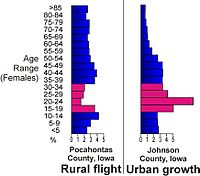
Photo from wikipedia
Urban–rural integration development (URID) is the solution to the excessive urban–rural gap, unequal and insufficient development in urban–rural areas, along with the process of dynamic and balanced urban–rural growth. The… Click to show full abstract
Urban–rural integration development (URID) is the solution to the excessive urban–rural gap, unequal and insufficient development in urban–rural areas, along with the process of dynamic and balanced urban–rural growth. The promotion of high-quality development and sustainable development in the Yellow River Basin (YRB) depends heavily on the scientific development of an evaluation index for urban–rural integration (URI), the quantitative measurement of the level of URI, and the accurate identification of the spatial layout of URI. The URI indicator system is built using the new development philosophy, and 94 cities in the YRB are used as samples. The spatial and temporal evolution characteristics of the URID in the YRB were studied from 2010 to 2020 using the entropy value method and coupled coordination model. The study shows that from 2010 to 2020, along the YRB, both urban and rural development (URD) levels generally increased. However, regional differences increased and development levels varied, showing a trend of uneven development between provinces. Overall, the degree of URID was increasing and still low, but there are three main types of urban–rural coupling and coordination (URCC) that are relatively stable: barely coordinated, primary coordination, and on the verge of disorder. Primary coordination replaced barely coordinated as the dominant type over time. Finally, it is suggested that urban and rural regions should not be “managed separately” but rather should be viewed as a cohesive organic whole; to drive urban cluster construction and spur rural development, to further close the urban–rural divide, reliance on the city centre is necessary. Concurrently, this encourages the transfer of farm labour and supports the coordinated growth of urban–rural industries; investment in advantageous industries is strengthened; the construction of URIs should be promoted at a more microscopic city and county level; and strong support is provided to achieve high-quality sustainable development of the YRB. It is important to put into practice the new development philosophy, investigate the fundamental causes of the growing urban–rural divide, change the development strategy, and optimize this new development path.
Journal Title: International Journal of Environmental Research and Public Health
Year Published: 2022
Link to full text (if available)
Share on Social Media: Sign Up to like & get
recommendations!